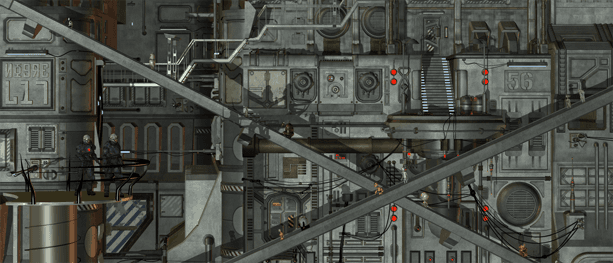SUPER ESCALATORS (SUPES)
 Super Escalators (SUPES) were developed with security input from the CMSB. Junction Levels were created as a physical buffer zone between the Upper City and Lower Levels of each Conglomerate Space Station (CSSTAT). SUPES (multi-mile long escalators) were designed to move more people continuously (vs. tube transport), run on very little power and with few parts to fail.
Super Escalators (SUPES) were developed with security input from the CMSB. Junction Levels were created as a physical buffer zone between the Upper City and Lower Levels of each Conglomerate Space Station (CSSTAT). SUPES (multi-mile long escalators) were designed to move more people continuously (vs. tube transport), run on very little power and with few parts to fail.Stationary checkpoints built along (and into) SUPES expressways allow for rapid, thorough screenings of those who use them before they accessed manned checkpoints in the Upper City.
Mobile security droids were introduced after a successful bomb detonation by Syrhani’i terrorists on CSSTAT-1, SUPES 2.22, Segment 742 in 2317. Armed with an array of weapons detection sensors, SUPES SECDROIDS can move in three dimensional space around the SUPES itself and have the ability to snatch individuals off the track if an imminent threat is detected. “Catcher” units also float nearby in case pieces from a detonation need to be plucked from the air before causing further damage to the SUPES system.
Known colloquially as “Stairways to Heaven,” SUPES can be found in abundance crisscrossing the Junction Levels. It is rare to find a SUPES where one can see the far end in under 3 minutes of stepping onto the rapid conveyor. The speed of a particular SUPES depends on the distance travelled. Longer expressways move considerably faster than short “Sprinter” lanes.
HISTORY
Original CSSTAT designers did not foresee the massive interior spaces afforded by modern day construction methods. CSSTAT-1's only inhabitants were to be Conglomerate officials, their families and other wealthy individuals. The construction of the first CSSTAT reflected this.
The ability to traverse many kilometers in any direction was accomplished by express tubes. Permanent transportation systems were still under construction. The bulk of these tubes spidered out to floating shuttle docks to efficiently move construction and engineering personnel to and from the station and temporary space bunkers.
CSSTAT-1 “elevators” were, at the time, the longest ever built (many as long as 5 km stretching out to geosynchronous external shuttle bays, with as few as three stops) connecting the furthest points within it to no more than three or four transfers.
Long-term residents started to move in as various decks were safety cleared by Stationmasters. In a rather unexpected turn of events, the high-risk for high-pay terms of many laborers allowed them to save enough to take-up permanent residence on the station in what would eventually become the Lower Levels.
Tube capacity was rapidly deemed inadequate for proper station function. The social friction created by transporting Elites and non-Elites in tight quarters out of necessity created problems of their own. Once permanent transportation options became operational, the long range elevators were dismantled and replaced by the SUPES system.